Canadian investigators have determined that pilots of a Cougar Helicopters S-92 that ditched off the coast of Newfoundland on 12 March had attempted to autorotate the twin-engine heavy helicopter into the icy Atlantic after the tail rotor drive had failed.
The two pilots and 16 passengers of Flight 491 had been enroute to offshore oil platforms that morning at 9,000ft (2,743m) when the crew reported the loss of all oil pressure in the helicopter’s main gearbox (MGB), the mechanism that transfers power from the twin General Electric CT7-8A turboshaft engines to the main rotor and tail rotor. The helicopter descended to 800ft and was returning back to the coast when pilots radioed that they were preparing to ditch. Rescuers on a second helicopter pulled one survivor from the water.
Though power to the flight data and voice recorders was cut off for as yet unexplained reasons just as the helicopter began descending from 800ft in preparation for ditching, the Transportation Safety Board of Canada (TSB) team was able to gather information from the helicopter’s health and usage monitoring system (HUMS) and flight control computer to be able to “piece together most of Cougar Helicopters Flight 491’s flight profile below 800ft,” officials say in an 18 June update on the accident.
Forensics from the recovered MGB revealed that two of three titanium MGB oil filter bowl studs had cracked, which likely lead to the loss of oil in the MGB and the failure indications in the cockpit. The US Federal Aviation Administration later required all S-92 operators to immediately change out the titanium studs for steel equivalents in an emergency airworthiness directive. The picture below shows a missing titanium mounting stud on the MGB oil filter.
 ©TSB
©TSB
The post-crash MGB analysis also showed that there was “no loss of main rotor drive” though the tail rotor drive gears had been “severely damaged, resulting in the loss of drive, causing it to stop producing thrust.” The picture below, shows the damaged tail rotor take-off gear from Flight 491, compared to an undamaged pinion.
 ©TSB
©TSB
Reconstructed flight performance data reveals that the helicopter had slowed to 85kt (157km/h) as it descended through 500ft, after which pilots began shutting down both engines, “which was consistent with a tail rotor drive failure emergency”. Without the ant-torque control produced by the tail rotor, a helicopter is uncontrollable in its yaw axis when the engines are producing torque.
After the shutdown, TSB says Flight 491’s pitch attitude increased from approximately 10 degree nose down to about 16 degree nose up, “which is consistent with a flare for an engines-out landing”. Investigators say the helicopter struck the water in a slight right-banked, nose-high attitude… with a moderate speed and a high rate of descent.”
It remains a mystery why the helicopter’s flotation system did not active after the impact with the water, which the TSB had previously estimated generated about 20g of force. The TSB says the flotation system activation switch was found in the armed position after recovery; however the inflation bottles did not release their compressed gas to inflate the flotation collars.
Source: FlightGlobal.com























